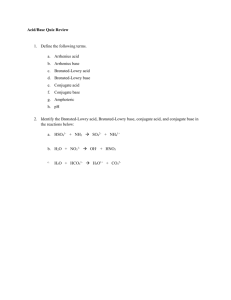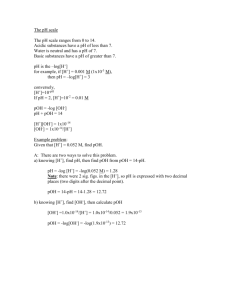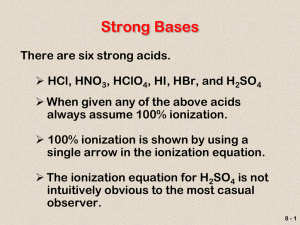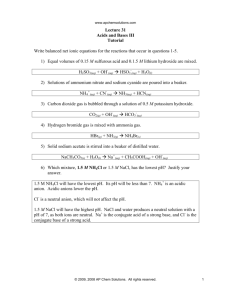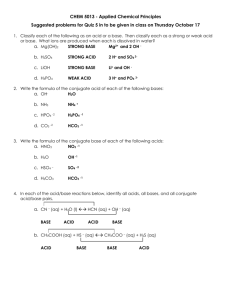16.1-16.5 Notes
advertisement
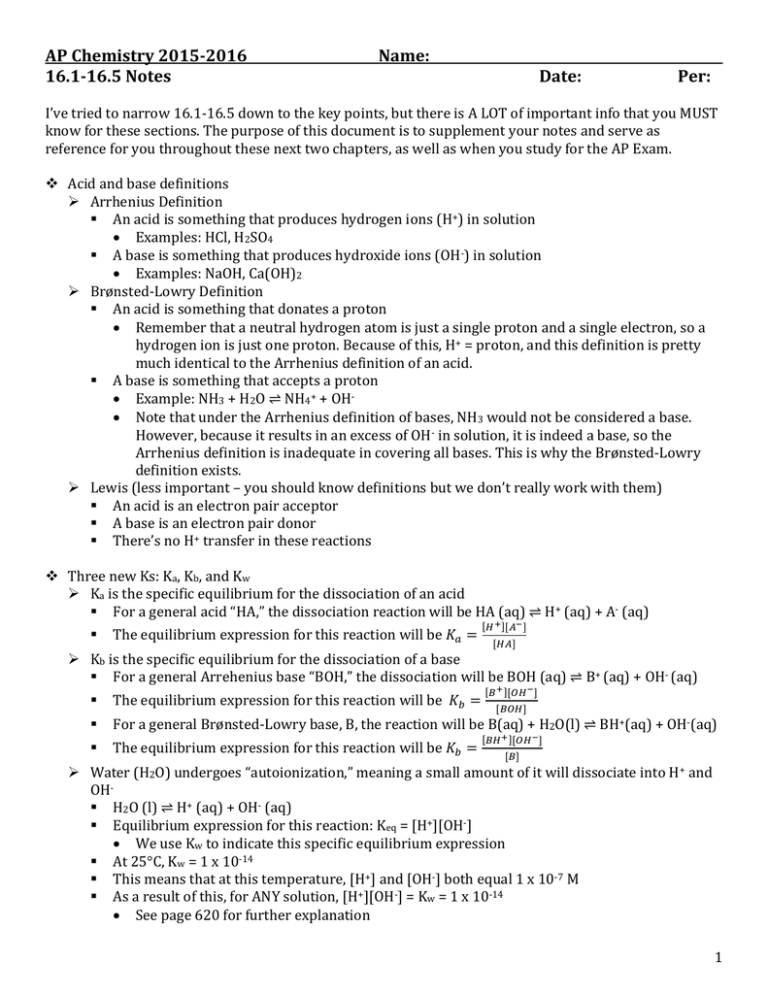
AP Chemistry 2015-2016 16.1-16.5 Notes Name: Date: Per: I’ve tried to narrow 16.1-16.5 down to the key points, but there is A LOT of important info that you MUST know for these sections. The purpose of this document is to supplement your notes and serve as reference for you throughout these next two chapters, as well as when you study for the AP Exam. Acid and base definitions Arrhenius Definition An acid is something that produces hydrogen ions (H+) in solution Examples: HCl, H2SO4 A base is something that produces hydroxide ions (OH-) in solution Examples: NaOH, Ca(OH)2 Brønsted-Lowry Definition An acid is something that donates a proton Remember that a neutral hydrogen atom is just a single proton and a single electron, so a hydrogen ion is just one proton. Because of this, H+ = proton, and this definition is pretty much identical to the Arrhenius definition of an acid. A base is something that accepts a proton Example: NH3 + H2O ⇌ NH4+ + OH Note that under the Arrhenius definition of bases, NH3 would not be considered a base. However, because it results in an excess of OH- in solution, it is indeed a base, so the Arrhenius definition is inadequate in covering all bases. This is why the Brønsted-Lowry definition exists. Lewis (less important – you should know definitions but we don’t really work with them) An acid is an electron pair acceptor A base is an electron pair donor There’s no H+ transfer in these reactions Three new Ks: Ka, Kb, and Kw Ka is the specific equilibrium for the dissociation of an acid For a general acid “HA,” the dissociation reaction will be HA (aq) ⇌ H+ (aq) + A- (aq) The equilibrium expression for this reaction will be 𝐾𝑎 = [𝐻 + ][𝐴− ] [𝐻𝐴] Kb is the specific equilibrium for the dissociation of a base For a general Arrehenius base “BOH,” the dissociation will be BOH (aq) ⇌ B+ (aq) + OH- (aq) [𝐵+ ][𝑂𝐻 − ] The equilibrium expression for this reaction will be 𝐾𝑏 = For a general Brønsted-Lowry base, B, the reaction will be B(aq) + H2O(l) ⇌ BH+(aq) + OH-(aq) The equilibrium expression for this reaction will be 𝐾𝑏 = [𝐵𝑂𝐻] [𝐵𝐻 + ][𝑂𝐻 − ] [𝐵] Water (H2O) undergoes “autoionization,” meaning a small amount of it will dissociate into H+ and OH H2O (l) ⇌ H+ (aq) + OH- (aq) Equilibrium expression for this reaction: Keq = [H+][OH-] We use Kw to indicate this specific equilibrium expression At 25°C, Kw = 1 x 10-14 This means that at this temperature, [H+] and [OH-] both equal 1 x 10-7 M As a result of this, for ANY solution, [H+][OH-] = Kw = 1 x 10-14 See page 620 for further explanation 1 Acids and Bases in Detail Acids The larger the Ka, the stronger the acid Strong acids – dissociate entirely Dissociation reaction goes to completion – not reversible Ka is very large (hardly any reactants left!) In solution, you will have H+ and A HBr, HCl, HI, H2SO4, HClO3, HClO4, HNO3 Weak acids – only partially dissociate Reaction is reversible; Ka is small In solution, you will have H+, A-, and HA Bases The larger the Kb, the stronger the base Strong bases – almost entirely dissociate Dissociation reaction goes to completion – not reversible Kb is very large (hardly any reactants left!) In solution, you will have B+ and OH- (only fits Arrhenius definition, however, all strong bases are Arrhenius) Group I and II hydroxides Weak Bases – only partially dissociate Reaction is reversible; Kb is small In solution, you will have Arrhenius: BOH, B+, and OH Brønsted-Lowry: B, BH+, and OH Acid Base Reactions An acid and base can react to neutralize each other General form for Arrhenius HA + BOH ⇌ BA + H2O BA is an “ionic salt” Salt is a general term in chemistry – not just NaCl General form for Brønsted-Lowry HA + B ⇌ BH+ + A Neutralization happens when MolesH+ = MolesOH Therefore neutralization occurs when, MH+*VH+ = MOH-*VOH Conjugate Acid Base pairs A conjugate acid/base pair is the acid and it’s conjugate base, or the base an it’s conjugate acid Example: NH3 + H2O ⇌ NH4+ + OH NH3 accepts a proton, so it’s a base. Its conjugate acid is NH4+ H2O donates a proton, so it’s an acid. Its conjugate base is OH-. Amphoteric substances: Substances that can act as both acids and bases Classic example: Water H2O as an acid (proton donor): NH3 + H2O ⇌ NH4+ + OH H2O as a base (proton acceptor): HCl + H2O ⇌ Cl- + H3O+ H+ and H3O+ In reality, very little H+ exists in solution because it’s so reactive. Instead, it bonds to a water molecule to form H3O+ (called the hydronium ion) Many chemists (and I) just write H+ because it’s easier and I’m lazy efficient. I won’t mark you down for it, and neither will the College Board. Just know that they are interchangeable. 2 pH and pOH pH “Power of hydrogen” is the measurement of how acidic a solution is More acidic = lower pH pH = -log[H+] Reverse: [H+] = 10-pH Typical scale: 0-14, however highly concentrated solutions ( >1.0M) will go beyond this Neutral = 7 Look at the [H+] for water at 25°C: 1 x 10-7 M. –log(1 x 10-7) = 7 pOH “Power of OH/Hydroxide” – measure of how basic a solution is More basic = lower pOH pH = -log[OH-] Reverse: [OH-] = 10-pOH Look at the [OH-] for water at 25°C: 1 x 10-7 M. –log(1 x 10-7) = 7 Relating pH + pOH If [H+] and [OH-] are related (through [H+][OH-] = 1 x 10-14), then pH and pOH are also related pH + pOH = 14.00. See page 624 for the explanation of this. Strong Acid pH calculations If all of your acid dissociates, then your ICE table would look like this: R HA -> H+ + AI 0.1M 0 0 C -0.1 +0.1 +0.1 E 0M 0.1M 0.1M Your reaction goes to completion, and [H+]E = [HA]I Therefore, for any strong acid pH = -log[HA] Example: what is the pH of 0.2M HCl solution? Answer: -log(0.2) = 0.7 Strong Base pH calculations Group I If your base fully dissociates, then your ICE table looks like this R BOH -> B+ + OHI 0.1M 0 0 C -0.1 +0.1 +0.1 E 0M 0.1M 0.1M Your reaction goes to completion, and [OH-]E = [BOH]I Therefore, for a group I base, pOH = -log[BOH] and pH = 14 + log[BOH] Group II If your base fully dissociates, then your ICE table looks like this R B(OH)2 -> B+ + 2OHI 0.1M 0 0 C -0.1 +0.1 +0.2 E 0M 0.1M 0.2M Your reaction goes to completion, and [OH-]E = 2*[BOH]I Therefore, for a group II base, pOH = -log(2*[BOH]) and pH = 14 + log(2*[BOH]) 3 Significant Figures and logarithms By this point you may be thinking about how sig figs work with logarithms – it’s different! Remember that for a logarithm, the initial number of your answer is determined by the place value of your input Example: log(4) = 0.602; log(40) = 1.602; log(400) = 2.602 As a result, this number also corresponds to the exponent on the 10 when your input is written in scientific notation Example: log(4 x 100) = 0.602; log(4 x 101) = 1.602; log(4 x 102) = 2.602 This means that in the output of your logarithmic calculation, the number before the decimal IS NOT SIGNIFICANT. It is merely an indication of scale (much like when a number is written in scientific notation, we don’t count the numbers in “10x” as significant figures). So if you’re taking a logarithm, your significance counting starts AFTER the decimal. Example: What is the pH of a 0.00653M HCl solution? pH = -log(0.00653) = 2.185086 The answer should have three significant figures. This means three digits AFTER the decimal. Answer: 2.185 When you’re going from a pH to a concentration, the digits in front of the decimal point on the pH are not significant. Example: what is [H+] for a solution with a pH of 3.54? [H+] = 10-pH = 10-3.54 = 2.88403 x 10-4 Our input (3.54) has two significant figures in it. Answer: 2.9 x 10-4 Estimating pH without a calculator It is completely reasonable for the College Board to ask you questions about pH on the AP exam in the multiple choice section. This means you will have to be able to estimate logarithms without a calculator. Consider the following facts: -log(1 x 10-1) = 1 -log(1 x 10-2) = 2 -log(1 x 10-3) = 3 -log(1 x 10-4) = 4 See the pattern? We can use this to estimate our pH. Step 1: identify the two numbers with a base of 1 that your [H+] is in between. Example: What is the approximate pH of an HCl solution with a concentration of 5.43 x 10-5 This number is smaller than 1 x 10-4 but bigger than 1 x 10-5 Step 2: identify the -log of these two base numbers -log(1 x 10-4) = 4 -log(1 x 10-5) = 5 Step 3: estimate your pH The pH of the solution will be between 4-5 You will not have to get more precise than this (actual answer: 4.265) 4
